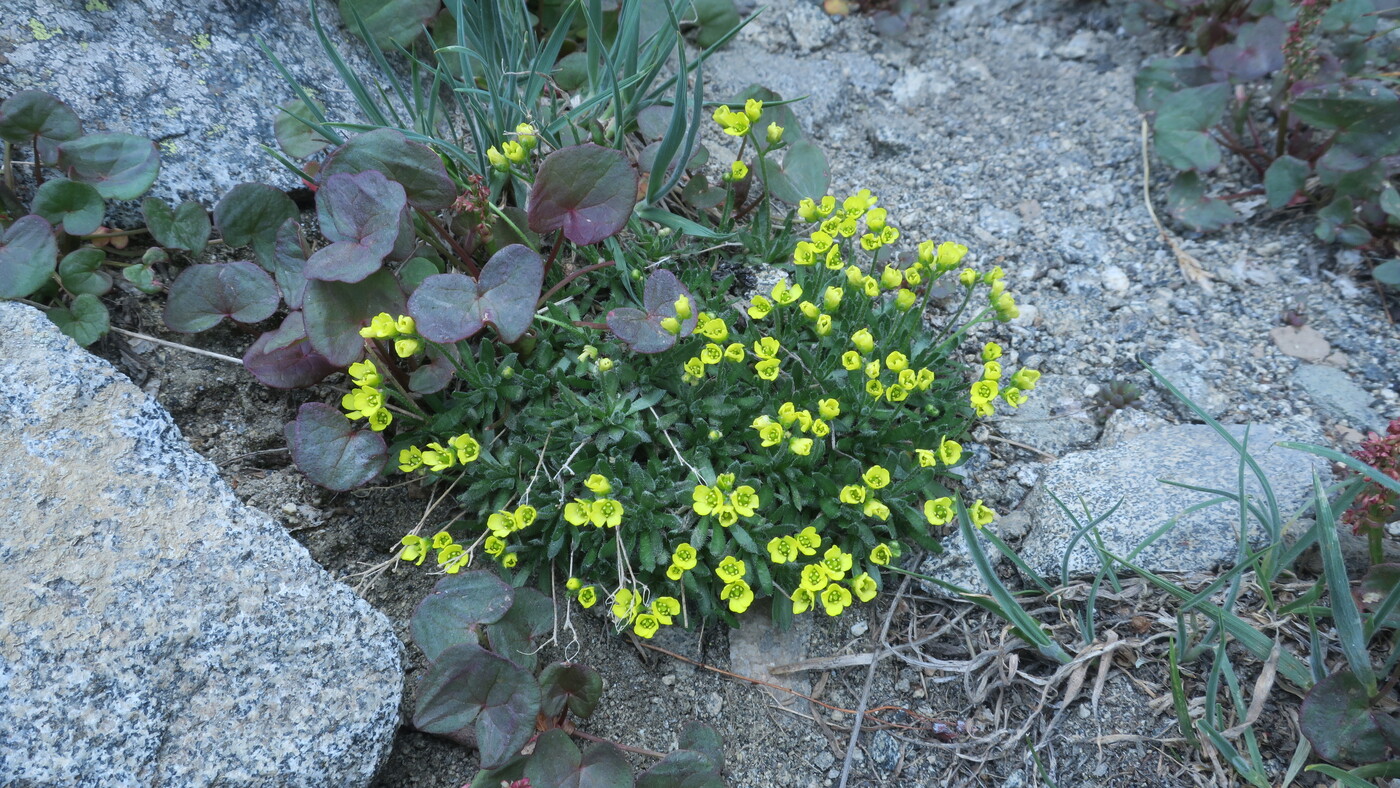
Plants perennial, cespitose, often pulvinate, scapose; caudices many-branched, some terminated in sterile rosettes.
Stems (1.5)4–14(21) cm, simple, pubescent with simple and 2–5-rayed or mostly subpectinate trichomes, sometimes glabrous distally.
Basal leaves rosulate, narrowly oblanceolate to linear, (4)6–17(25) × (1)1.5–3.5(5) mm, margins entire, ciliate, midveins usually obscure, surfaces pubescent with short-stalked, pectinate trichomes, at least a few 4–6-rayed, adaxially sometimes glabrous.
Cauline leaves absent or rarely 1, linear to oblong.
Inflorescences 3–14(30)-flowered, rachises straight, glabrous or pubescent; fruiting pedicels ascending, straight, (2.5)4–11(27) mm.
Flowers sepals ovate, 2.5–3.5(4) mm; petals oblanceolate to obovate, 4–6 × 1.5–2.5 mm, yellow fading to white; ovules 8–16(20) per ovary, styles 0.2–0.9 mm.
Fruits broadly ovate to lanceolate, flattened, untwisted, 5–9(11) × 2–4 mm, glabrous or puberulent with simple and 2-rayed trichomes.
Seeds oblong, flattened, 1.1–1.5 × 0.7–1 mm; wingless.
2n=112.
Rock outcrops, talus, gravelly areas. Flowering Jun–Aug. 2300–2500 m. BW. ID, NV, WA; north to AK, northeast to Northwest Territories, east to WY, southeast to CO, Quebec. Native.
as described under Draba incerta
Perennials; (cespitose, often pulvinate); caudex branched (dense with persistent leaf remains, branches sometimes terminating in sterile rosettes); scapose. Stems unbranched, (0.2-)0.4-1.4(-2.1) dm, often pubescent throughout, sometimes glabrous distally, trichomes often simple and 2-5-rayed, 0.1-0.5 mm, (sometimes with mostly subpectinate ones). Basal leaves rosulate; petiolate; petiole (0-1 cm), ciliate throughout; blade narrowly oblanceolate to linear, (0.4-)0.6-1.7(-2.5) cm × (1-)1.5-3.5(-5) mm, margins entire, (ciliate, trichomes usually simple, rarely 2-rayed, 0.2-1.1 mm), surfaces usually pubescent with short-stalked, pectinate trichomes, 0.15-0.5 mm, sometimes also with 4-6-rayed ones, (midvein usually obscure abaxially), sometimes glabrous adaxially. Cauline leaves usually 0 (or 1, as a bract); sessile; blade linear to oblong, margins entire, surfaces pubescent as basal. Racemes 3-14(-30)-flowered, usually ebracteate, rarely proximalmost flowers bracteate, elongated in fruit; rachis not flexuous, glabrous or pubescent as stem. Fruiting pedicels ascending, straight, (2.5-)4-11(-27) mm, glabrous or pubescent, trichomes 2-5-rayed or pectinate. Flowers: sepals broadly ovate, 2.5-3.5(-4) mm, pubescent, (trichomes simple and 2- or 3-rayed); petals yellow (fading white), oblanceolate to obovate, 4-6 × 1.5-2.5 mm; anthers ovate, 0.3-0.5 mm. Fruits broadly ovate to lanceolate, plane, flattened, 5-9(-11) × 2-4 mm; valves glabrous or puberulent, trichomes simple and 2-rayed, 0.05-0.3 mm; ovules 8-16(-20) per ovary; style 0.2-0.9 mm. Seeds oblong, 1.1-1.5 × 0.7-1 mm. 2n = 112.Flowering Jun-Aug. Rock outcrops, talus, gravelly areas, tundra; 0-3300 m; Alta., B.C., Que., Yukon; Alaska, Colo., Idaho, Mont., Nev., Utah, Wash., Wyo.Draba incerta was shown by G. A. Mulligan (1972) to be sexually reproducing and 14-ploid with x = 8. It is often confused with the apomict D. oligosperma (2n = 32, 64). Draba incerta is readily separated from D. oligosperma by having well-formed (versus abortive) anthers and pollen, stalked (versus sessile) leaf trichomes, and ciliate (versus non-ciliate) basal leaves with obscure (versus prominent) midveins. Although both species have leafless scapes, one often finds a bract adnate to, or subtending, the proximalmost pedicel in D. incerta.Draba incerta is found near sea level in Alaska.